

Members' Pages
This page is reserved for contributions from members and school pupils.
This item is by Wilma Marshall.
Introduction
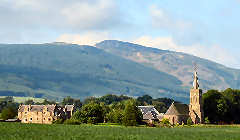
All that's left of Duncrub House. |
Visitors often ask about the church visible a little to the north-west of the village on the Duncrub estate, the seat of the Rollo family since the fourteenth century.
In 1861 John Rogerson Rollo, the ninth baron, built a magnificent Victorian edifice known as Duncrub House. It had fifty rooms and more windows and doors than days in the year. Sadly, it did not last long. When the twelfth Lord Rollo inherited it in 1946 he found it to big to live in and too big to heat, so he sold it and it was demolished in 1950.
All that remains is its chapel and part of the west wing, which was the servants' quarters. These are both now private residences. The current owners are James and Wilma Marshall. In December 2004 they very kindly invited the Society to visit the chapel, and told us of its history. The following are some notes made by Wilma for that event.
The Rollos of Duncrub
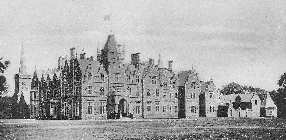
Duncrub House at its prime. |
King David the Bruce died in 1371 and was succeeded by Robert, the Steward of Scotland and Earl of Strathearn. John de Rollo obtained from that Prince a charter, dated at Methven, 14th February, 1380-1, confirming the grant formerly given to him 'de terries de Findony, cum parte de Dunyn, et de terries de Dumcroube et de Ladcathy' (that is, of the lands of Findony, with part of Dunning and of the lands of Duncrub and Ledketty).
But the Rollo family trace back their lineage to a much earlier period. Eric Rollo, the Dane, had obtained a settlement in Normandy so early as the eighth century, and from him were descended the Dukes of Normandy, in the line of whom, passing over several generations, we come to William the Conqueror, who became King of England in 1066. Eric de Rollo, a scion of the same stock, accompanied the Conquerer to England in the capacity of Secretary. A portrait of him, taken in his ninety-eighth year, is said still to be in possession of the family. A descendant of his came to Scotland, as many other Normans did, in the time of David 1., about the year 1130, and obtained from that monarch a grant of houses and lands in the Lothians. From him descended John de Rollo above named, who, in the following century, settled in Perthshire, and founded the family of Duncrub.
The lineage is followed down through the centuries until William, the ninth Baron, died in 1852, leaving an only son, viz., John Rogerson Rollo, Lord Rollo, in the Peerage of Scotland, and Baron Dunning of Dunning and Pitcarins in the Peerage of the United Kingdom. Since his accession, his Lordship has greatly extended and improved the family estates, having acquired the lands in the parish of Dunning, and other lands of Kelty, Boghall, Steelend, Greenhill, Midgemill, and Knowehead, in the parish of Auchterarder. He has also erected a splendid mansion at Duncrub, and many neat and comfortable houses for the accommodation of his tenants. He takes an active interest in the prosperity of all who reside on his property, and is ever ready to promote any undertaking that he considers calculated to the moral or physical well-being of the parishioners of Dunning.
The original house of Duncrub, to which Robert Burn added wings in 1799, was remodelled and greatly enlarged in 1836-7 by his son William Burn, for the 8th Lord Rollo. In 1870 Burn's house was demolished and replaced by one by Habershon and Pite. This in turn was demolished in 1950, the lists saying only the laundry remains, containing some masonry of c. 1880. The park had been altered by Walter Nicol c. 1800.
Duncrub Park was purchased by John Marshall in 1950.
From 'The Imperial Gazetteer of Scotland, Topographical Statistical and Historical' edited by The Rev. John Marius Wilson, published by Fullerton and McNab, we read,
DUNCRUB, the estate and residence of Lord Rollo, in the parish of Dunning, Perthshire. Lord Rollo is a lateral descendant of Rollo the Dane, and of Rollo the first Duke of Normandy, through branches who came to England with William the Conqueror and to Scotland in the reign of David 1. The estate of Duncrub was a grant to the family of Rollo, in 1380, by David Earl of Strathearn, with the consent of King Robert, his father. In 1512, it was erected into a free barony; and in 1651, its then proprietor, Sir Andrew Rollo, was raised by Charles 11, to the dignity of Baron Rollo of Duncrub.
From Ordinance Gazetteer of Scotland: A Survey of Scottish Topography, Statistical, biographical, and Historical, edited by Francis H. Groome, published by William Mackenzie, are the following extracts
DUNCRUB, an estate, with a mansion, in Dunning parish, SE Perthshire, 1 mile WNW of Dunning town. Granted to John de Rollo in 1380 in 1511 into a free barony, it is now held by John Rogerson Rollo, the tenth Baron Rollo of Duncrub, in the peerage of Scotland since 1651, and first Baron Dunning of Dunning and Pitcairns in that of the united Kingdom since 1869 (b 1835; suc. 1852)
The present chief is the thirteenth Lord Rollo and fourth Baron Dunning and lives in Perthshire

Duncrub in the Autumn. |
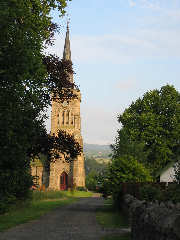
The Chapel Tower. |

Chapel Ceiling |
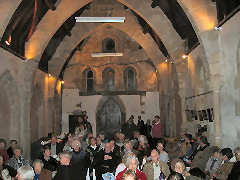
The Chapel Roof. |
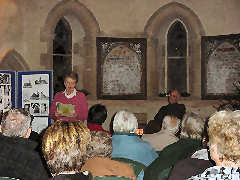
Wilma and James Marshall |
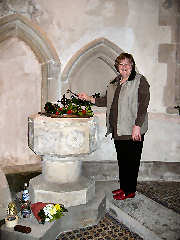
Liz Fletcher at the font |